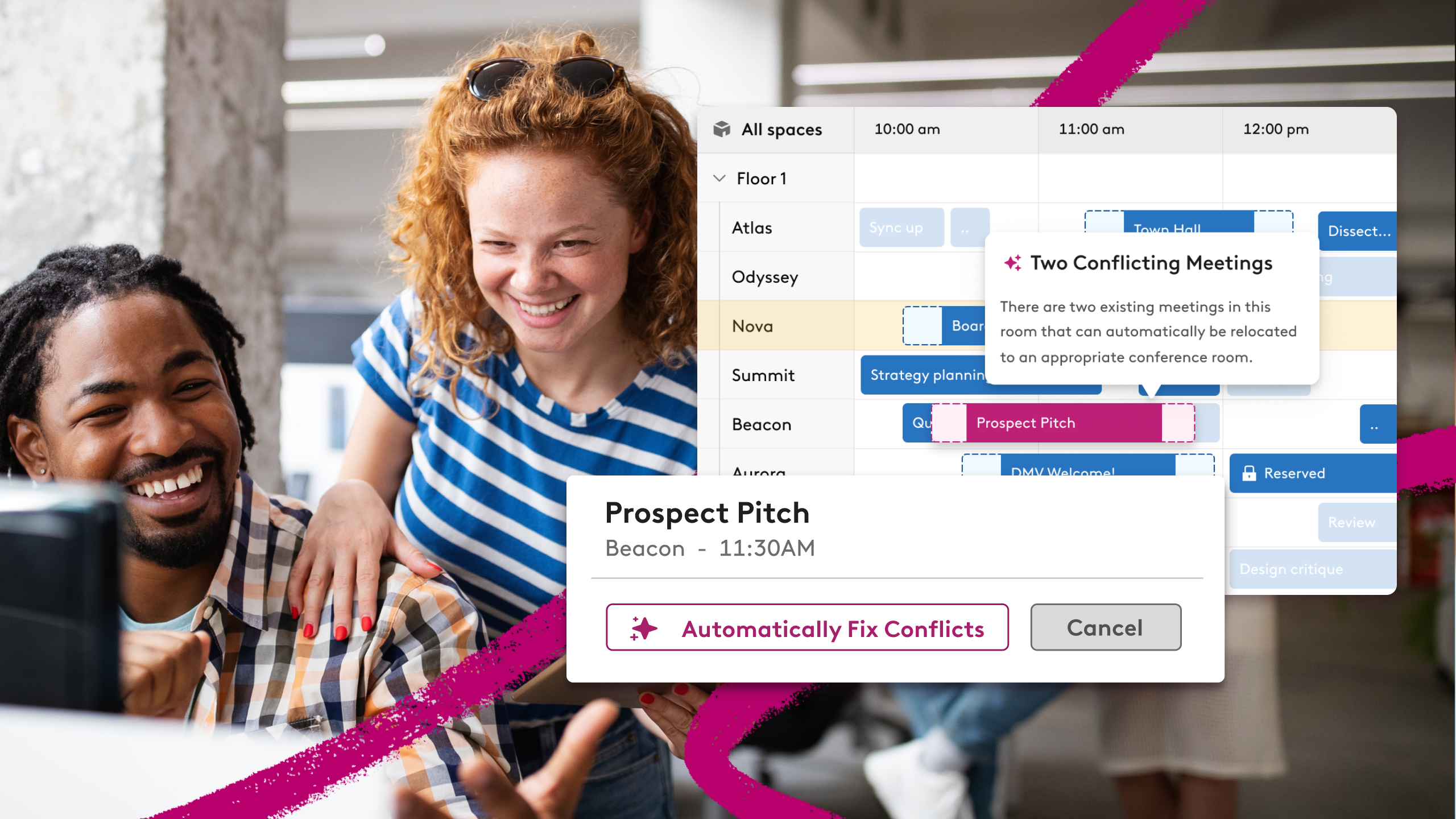Workplace Technology 201: Why You Need the Right Workplace Management Solutions ASAP

Offices used to be the central hub for everything, especially technology.
Tools were built around your physical spaces. Employees needed to be at a desk near a company server. Leaders needed to be on-site for every meeting.
Everything that enabled your team to work existed within the walls of your office. Even as remote work started to gain traction pre-pandemic, companies weren't changing their physical or digital infrastructure to truly meet the needs of both office work and working remotely.
But the tides have changed. We know remote work AND office work can exist in harmony, you just need the right support in place. The key is to have the technologies in place to support employees, meaning there should be a relatively equitable experience for your people regardless of where they are working from that day.
In order to truly build a hybrid workplace experience, you’ll need a line-up of tools that can enable your teams to communicate, collaborate and contribute.
We call these individual tools a workplace tech stack. When you can access these solutions from one place, we call that a workplace management platform. Let's explore.
What Is A Workplace Tech Stack?
The early days of the pandemic were full of quick-fixes for ‘temporary’ remote work. Nearly two years later these quick fixes have turned into long-term assets for organizations with an increasingly mobile workforce.
Workplace tech stack: A set of technologies that work in tandem to enable a better workplace experience for your teams.
Technology is more important than ever in a hybrid workplace because it allows distributed workers to seamlessly collaborate. Building an equitable system is one of the most important steps towards making flexible work stick.
Whether that means investing in a platform for collaboration or software that facilitates meetings with a mix of on-site and off-premise workers - your technology will empower your teams to comfortably work where they want.
Workplace teams — generally made up of IT, Facilities, HR professionals or a mix of the three —lead the charge with these implementations. It’s no coincidence that we are seeing more job postings around workplace experience. Businesses are investing in functions that can spearhead the adoption of new technologies and processes to enable a more hybrid workplace.

For employees to feel fully supported, workplace experience leaders must find the right tools for their team and ensure a smooth rollout. The less friction you have, the more likely your employees are to adapt to the changes.
Broadly speaking, the technology in your workplace stack will cover a few key areas:
- Bookings: Reserving meeting rooms, scheduling office visits, booking a desk - these are all actions associated with schedule management of shared resources.
- Visitor Management: Planning for client visits, registering office guests, providing resources for anyone new to the office - these are all actions associated with managing visitors in your office space.
- Space Planning: Finding data around occupancy, determining what resources are or are not being used, planning office layouts - these are all actions associated with understanding your spaces and planning for the present and future.
- Meeting Services: Organizing large client or executive, managing catering, AV, and room setup - these are all actions associated with planning effectively for on-sites and meeting needs.
- Workplace Analytics: Understanding office activity, building custom reports to demonstrate ROI to their stakeholders - these are all actions associated with surfacing the right data to secure leadership buy-in and build more purposeful offices.
The combination of these tools makes up the foundation of how your teams work. In a world where more flexible working options are the norm, these tools will play an increasingly important role. In particular, your ability to measure demand and office usage will empower you to make data-backed decisions about how to move forward with your spaces.
How to Determine What Your Offices Need: 5 Quick Questions
Your workplace tech stack exists to empower your teams and the work they do. Here are a few quick tips on how to start building an ideal workplace tech stack.
1. Run a tech audit: Start by surveying what kind of tools you already have at your disposal. Are they conducive to collaboration and communication? Do they take hybrid work into consideration?
2. Talk to your teams: At the end of the day, if your team doesn’t use your tools, they’re useless. Get a feel for what your team needs and how they prefer to work.
3. Consider IT integrations: Will these new tools easily fit into your existing tech stack? Work with your IT team to ensure everything is secure and that implementation won’t be a nightmare.
4. Review additions: Once you’ve added another layer to your workplace tech stack, set aside time to review. Is the new tool working? Where are the gaps? Is there a better solution out there?
5. Rinse and repeat: Start from the beginning with each new tool you consider.
Centralize Your Office Tools with a Workplace Management Platform
It's great to find the right technology solutions to address your office friction points. But what happens when your tech stack starts becoming too cumbersome?
Chances are your company (and it's offices) are growing. It's a good problem to have until you realize you spend more time switching between different tools than actually getting work done.
There is a wide range of workplace technology out there. From messaging platforms for virtual communication to office management software for booking spaces, you may need a few tools in place to accomplish all of your needs. But, perhaps, the most fundamental of all are the tools that can centralize the management of office operations.

With a single platform, workplace leaders, IT managers and office specialists can:
- Facilitate flexible work: Empower hybrid employees to get the office resources they need, when they need them, for more intentional in-person time.
- Centralize workplace operations: Manage your spaces, services, deliveries, office visitors and more from a single, integrated workplace platform.
- Optimize office spaces: Connect space data with employee insights to drive your workplace strategy, prioritizing your people and maximizing your investments.
By consolidating the various tools that help organizations achieve the above, you save time for both employees and admins. Instead of learning 5 different solutions, teams can focus on mastering a single platform. This not only results in more productivity but makes change management easier across offices.
Uplevel Your Office Game: The Power of Workplace Data
When workplace leaders can see data around who is in the office, they can make better decisions about company spaces.
Real estate is a significant investment and to be more cost-effective, workplaces are laser-focused on allocating the right resources in every office space. Teams work differently so offices need to both cater to individual needs while being effective for the most people possible.
For example, let’s say half of your employees are engineers and the other half are sales, marketing, HR and support workers. You can then look at the percentage of office use by each team.
If all of the engineers want to work from the office more, that changes how you plan. Companies need to be sure that they have the right tools in place for them to get their work done.
For teams that maybe want more freedom in their schedule, office IT leaders need to have the right tech in place to support better video conferencing solutions or new microphones in larger spaces. The focus here is on creating an equitable experience regardless of physical location.
Your workspace and its technologies should be reflective of who’s actually using them; data enables that.

With the right technology, you can even collect high-quality data around the equipment in your workspaces. This empowers employees to book the right rooms with the right tech and opens up a stream of data for you around equipment usage. When you have high quality workplace data at your fingertips, you can close feedback loops with your teams quicker. You’ll be able to respond with changes that meet your employees' needs, leaving everyone happier and more productive.
Building A Powerful Tech Plan for Your Workplace
This is a momentum-building year for hybrid work and there’s a huge opportunity for businesses to re-establish the workplace as a tool for organizations, people, and teams. Workplaces aren’t exclusively physical locations anymore. They are fluid, they exist across a range of touchpoints and they are evolving by the minute.
Interested in getting started? Sign up for a demo of Robin today!













